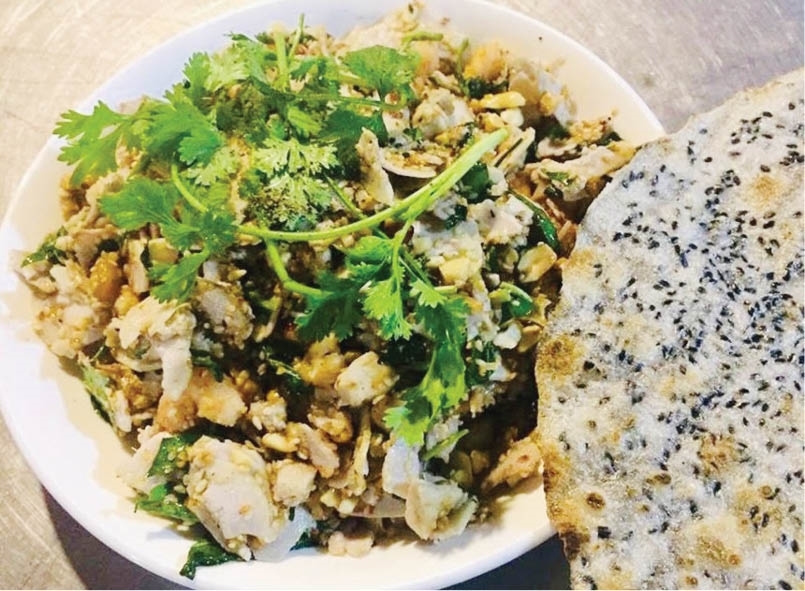In early summer, many women are seen carrying basket of green vegetables and fruits along Phan Dinh Phung and Dien Bien Phu streets. Among the fruits, there is roxburgh fig (scientific name: Ficus auriculata), a type of fruit much found in Hue.
In a garden of a Hue household, there is often a roxburgh fig tree with large foliage and fruits growing thickly at the base. Roxburgh fig leaves are used to wrap vegetables and the fruits are used as an ingredient in many recipes. Apart from fig tea, there are fig salad, stewed fig, sweet-and-sour pickled fig, fresh fig and herbs dipped with shrimp sauce, etc. Among these, fig salad is the most delicious in both Hue everyday meals and feasts.
This time is also the season of jackfruit. Jackfruit is available in many places, but in Hue, both young and ripe jackfruits are in favor. Housewives in Hue can make many delicious dishes for summer days from young jackfruits, such as young jackfruit stewed with shrimp and piper lolot, young jackfruit mixes shrimp with meat; and jackfruit is also present in many vegetarian dishes. Fig salad, young jackfruit salad, and banana flowers salad are among rustic specialties of Hue, used as appetizers for parties. Anyone who has eaten them will never forget.
    |
 |
| A rustic dish of Hue people. Photo: Bao Phuoc |
Amid the summer heat, if you go to Kim Long and Nguyet Bieu, you will enjoy mangosteen. The fruit widely found in the South is grown in Hue, but is not grown in the North.
Mangosteen grown in Hue is popular for its sweet taste despite the modest quantity of harvest. When you visit a fruit stall and ask about the price, you will hear the saleswoman say: “Hue mangosteen should be expensive!”
It’s the lotus season on the hottest days in Hue. Between May and June, the lotus ponds around the Imperial Citadel and Tinh Tam Lake bloom brilliantly with pink and white colors and the green of leaves. Lotus petals create a poetic and romantic space.
In addition, there are also beautiful lotus ponds in the surrounding areas of Hue, such as the one in La Chu village and many other places. Lotus is a heritage, for beauty and business. When the lotus blooms, the lotus ponds attract people of all backgrounds from many places to come check-in and enjoy. The reason is everyone wants to have beautiful pictures with lotus. Also, lotus vases and lotus pots beautify any space.
Hue is well-known for dishes made from lotus, which are rich, delicate and macrobiotic. Each part from the lotus plant through the skills of Hue chefs can be turned into delicious dishes, such as lotus rice, lotus salad, lotus seed tea, lotus soup with longan. These become the main courses for Hue-styled parties.
By the end of summer, in July and early August, it is the season of Hue’s thanh tra (a type of citrus fruit grown in Hue). For a long time, thanh tra has been one of the specialties for the king, and now it is a famous garden specialty of the ancient capital.
Thanh tra used to be grown in Thuy Bieu (Hue City), but it is now organically farmed in many other places such as Huong Thuy, Huong Tra and Phong Dien.
Thanh tra has a cool, fresh taste, which is neither too sour or too sweet. Tasty and nutritious, it is a favorite gift for not only tourists but also the Hue people living away from their homeland. For its taste, thanh tra is not only a fruit to cool off the summer heat, it is also used to make many delicious dishes through the skills of Hue people. Thanh tra has become well-known for dozens of dishes with unique flavors.
Like the specialty of Hue lotus, thanh tra is a very special fruit because all parts of the fruit are used to make delicious dishes of high nutritional value.
Thanh tra’s peel is used to make jam, sweet soup. The segmented flesh is used to mix with squid for a delicious salad. It can be used in dishes such as steamed chicken, fried spring rolls or fermented pork rolls, and the beautiful name becomes part of the dish name. Therefore, thanh tra has become the first product in Hue to be certified by the Asian record organization as the culinary value of ASIA.
In compensation for the harsh climate, Hue is given the Huong River, the mountains and hills of the West, and the Tam Giang lagoon, etc., to make beautiful scenery and rich products. This is advantageous for the province of Thua Thien Hue to establish a brand of culinary capital, a center of culture and tourism with its own specificity.